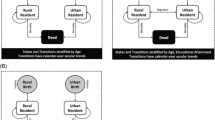Abstract.
The Integrated Analytical Model for Household Simulation (INAHSIM) is a microsimulation model for the Japanese population that was first developed in the 1980s as a tool for household simulation. This study attempted to improve the conventional INAHSIM in order to construct a more comprehensive alternative that incorporates a larger number of social and economic elements. It also overcame the problem for simulation—the lack of kinship relations in the initial population—by imputing parent-child relationships between those parents and children who do not live together. This paper provides an overview of INAHSIM and adds certain details of the imputation that is essential for simulating the life event of “adult children resettling to care for their aged parents.” In addition, I will show the importance of the said life event in Japan by comparing the difference in the family type of elderly people between its future distribution with or without this life event. Finally, I will discuss the future possibilities for research on microsimulation models that will play an important role in policy making.
Similar content being viewed by others
References
Williamson, P.: Editorial. International Journal of Microsimulation. 1(1), 1-2, 2007
Wolfram, S.: Cellular Automata and Complexity: Collected Papers. Perseus Books, 1994
Orcutt, G.: A new type of socio-economic system. Review of Economics and Statistics. 39(2), 116-123, 1957
Harding, A., Gupta, A.: Introduction and overview. Modelling Our Future: Population Ageing, Social Security and Taxation. 2007
Aoi, K., Okazaki, Y., Fukawa, T., Hanada, K., et al.: Household projection by INAHSIM: A comprehensive approach. Life Span. 6, 1986 (in Japanese)
Inagaki, S.: An analytical model on household and family via micro simulation (INAHSIM). Bulletin of the Institute of Actuaries of Japan. 39, 89-188, 1986 (in Japanese)
Fukawa, T.: Future trends of Japanese households through micro simulation model: An application of INAHSIM. The Journal of Population Studies. 18, 13-27, 1994
Fukawa, T.: Household projection 2006/07 in Japan using a micro-simulation model. IPSS Discussion Paper Series. 2007-E02, 2007
Inagaki, S.: Projections of the Japanese socio-economic structure using a microsimulation model (INAHSIM). IPSS Discussion Paper Series. 2005-03, 2005
Inagaki, S.: Future Socio-Demographic Population Structure of Japan: Projections by a dynamic Microsimulation Model (INAHSIM). Japan Statistical Association. 2007 (in Japanese)
Inagaki, S.: The impact of the increase in non-regular employment on income disparities. Journal of Income Distribution. 16, 71-87, 2007
Author information
Authors and Affiliations
Corresponding author
Rights and permissions
About this article
Cite this article
Inagaki, S. A Microsimulation Model for Projections of Japanese Socioeconomic Structure. Rev Socionetwork Strat 2, 25–41 (2008). https://doi.org/10.1007/s12626-008-0003-5
Received:
Accepted:
Published:
Issue Date:
DOI: https://doi.org/10.1007/s12626-008-0003-5




